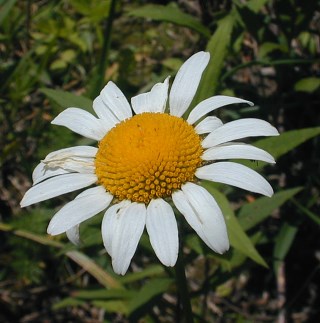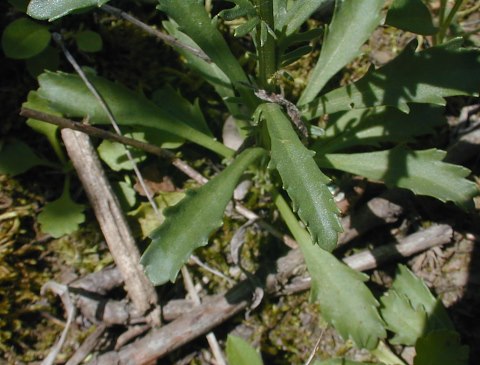Description:
This
herbaceous perennial plant is 1-3' tall and little branched. The
central stem is glabrous to slightly hairy and often angular or
furrowed. A small tuft of basal leaves develops at the base of the
plant, while alternate leaves occur sparingly along the central stem.
These leaves are up to 5" long and ¾" across, becoming smaller as they
ascend the stem. The basal and lower leaves are often oblanceolate with
slender petioles, while the middle to upper leaves are more oblong and
often clasp the stem. Their
margins are coarsely dentate, and some of
the alternate leaves are often pinnatifid toward the base. The upper
and lower surface of each leaf is hairless (or nearly so). The central
stem terminates in a single flowerhead on a long stalk that is nearly
naked. This flowerhead spans about 1¼–2" across and has a typical
daisy-like appearance. It consists of 15-35 white ray florets
surrounding numerous tiny disk florets that are yellow. The receptacle
of the disk florets is noticeably flattened. Each disk floret has 5
tiny lobes at its apex and is perfect, while each ray floret consists
of a white oblong petal and is pistillate. At the base of the
flowerhead, are several series of green floral bracts with margins that
are brown and membranous. The blooming period occurs during early to
mid-summer and lasts about 1½ months. Each floret is replaced by an
oblongoid dark achene that has about 10 light ribs. The achenes are
without tufts of hair. The root system is densely fibrous and forms
offsets from short rhizomes. This plant often forms dense colonies
where it is allowed to grow undisturbed.
clasp the stem. Their
margins are coarsely dentate, and some of
the alternate leaves are often pinnatifid toward the base. The upper
and lower surface of each leaf is hairless (or nearly so). The central
stem terminates in a single flowerhead on a long stalk that is nearly
naked. This flowerhead spans about 1¼–2" across and has a typical
daisy-like appearance. It consists of 15-35 white ray florets
surrounding numerous tiny disk florets that are yellow. The receptacle
of the disk florets is noticeably flattened. Each disk floret has 5
tiny lobes at its apex and is perfect, while each ray floret consists
of a white oblong petal and is pistillate. At the base of the
flowerhead, are several series of green floral bracts with margins that
are brown and membranous. The blooming period occurs during early to
mid-summer and lasts about 1½ months. Each floret is replaced by an
oblongoid dark achene that has about 10 light ribs. The achenes are
without tufts of hair. The root system is densely fibrous and forms
offsets from short rhizomes. This plant often forms dense colonies
where it is allowed to grow undisturbed.
Cultivation:
The preference is full or partial sun, mesic to slightly dry
conditions, and soil containing loam, clay-loam, or sandy loam.
This is a reliable and rugged
plant.
Range & Habitat:
The Ox-Eye Daisy has naturalized in most counties of Illinois and is
fairly common (see Distribution
Map). It was introduced into the United States from Eurasia
as an ornamental plant. Habitats include mesic to dry prairies
(including old cemetery prairies), sand prairies, weedy meadows in
wooded areas,
vacant lots, areas along roads and railroads, landfills, pastures, and
waste areas. This plant is usually found in degraded areas, but it also
persists in higher quality habitats. The Ox-Eye Daisy is often grown in
flower gardens, from which it may escape. Sometimes the rhizomes
survive earth-moving operations, thereby establishing colonies of
plants in new areas.
Faunal
Associations:
The nectar and pollen of the flowers attract a variety of insects,
including small bees, flies, beetles, wasps, small butterflies, and
skippers. The caterpillars of the moths Cnephasia longana
(Omnivorous Leaf-Tier) and Chlorochlamys chloroleucaria
(Blackberry Looper Moth) feed on the foliage. Livestock and probably
other herbivores eat the foliage occasionally; the seeds can pass
through the digestive tracts of these animals and remain viable. This
introduces colonies of the plant into new areas.

Photographic
Location:
A waste area behind a rural cemetery in Champaign County, Illinois.
Comments:
This is a classic example of a daisy. There are many white daisies that
have been introduced from Eurasia as ornamental and herbal plants,
although the Ox-Eye Daisy has larger flowerheads (more than 1¼"
across). The various cultivars of Leucanthemum x superbum
(Shasta Daisy) can closely resemble Ox-Eye Daisy in general appearance.
The Shasta Daisy was developed by Luther Burbank from Eurasian species.
Its flowerheads tend to be larger than those of the Oxeye Daisy (more
than 2" across) and its leaves are less likely to be pinnatifid. In the
Shasta Daisy, there is a brown membranous margin toward the apex of
each floral bract, while the floral bracts of the Ox-Eye Daisy are
brown along the entire length of their margins. Another scientific name
for the Ox-Eye Daisy is Chrysanthemum leucanthemum.